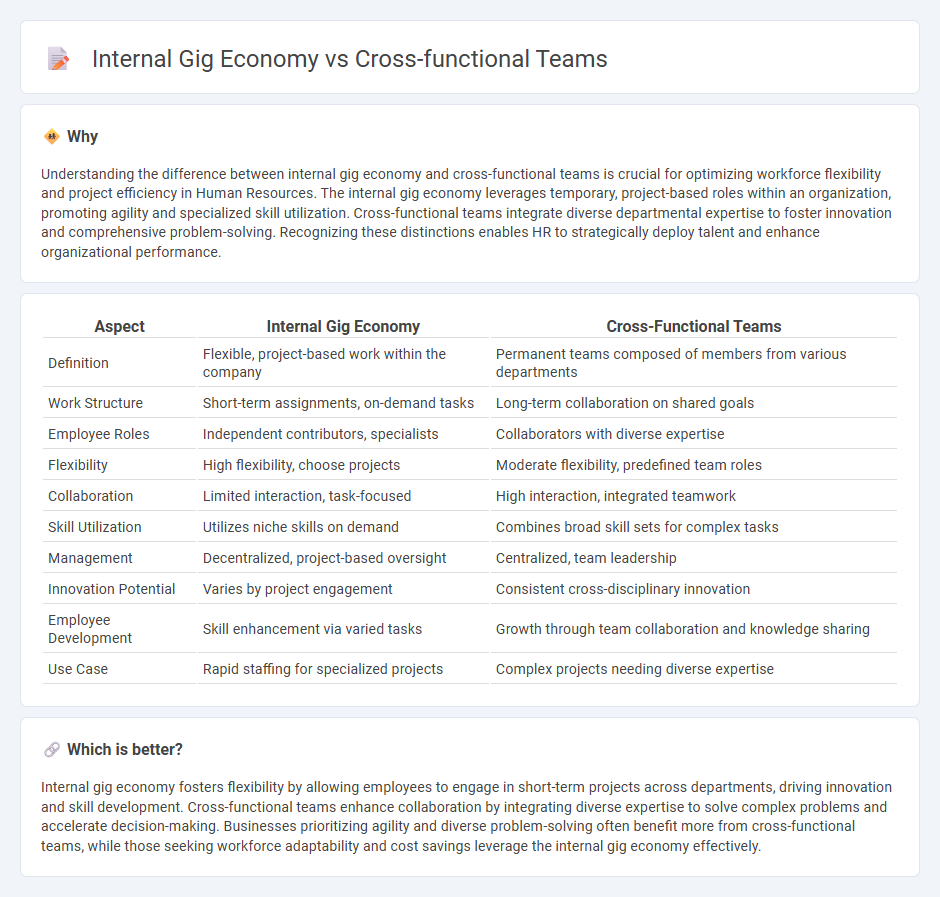
Internal gig economy leverages a flexible workforce by matching employees with short-term projects based on their skills, enhancing agility and reducing hiring costs. Cross-functional teams integrate diverse expertise across departments to foster innovation and accelerate problem-solving within organizations. Explore how these dynamic approaches reshape Human Resources strategies for improved talent utilization.
Why it is important
Understanding the difference between internal gig economy and cross-functional teams is crucial for optimizing workforce flexibility and project efficiency in Human Resources. The internal gig economy leverages temporary, project-based roles within an organization, promoting agility and specialized skill utilization. Cross-functional teams integrate diverse departmental expertise to foster innovation and comprehensive problem-solving. Recognizing these distinctions enables HR to strategically deploy talent and enhance organizational performance.
Comparison Table
| Aspect | Internal Gig Economy | Cross-Functional Teams |
|---|---|---|
| Definition | Flexible, project-based work within the company | Permanent teams composed of members from various departments |
| Work Structure | Short-term assignments, on-demand tasks | Long-term collaboration on shared goals |
| Employee Roles | Independent contributors, specialists | Collaborators with diverse expertise |
| Flexibility | High flexibility, choose projects | Moderate flexibility, predefined team roles |
| Collaboration | Limited interaction, task-focused | High interaction, integrated teamwork |
| Skill Utilization | Utilizes niche skills on demand | Combines broad skill sets for complex tasks |
| Management | Decentralized, project-based oversight | Centralized, team leadership |
| Innovation Potential | Varies by project engagement | Consistent cross-disciplinary innovation |
| Employee Development | Skill enhancement via varied tasks | Growth through team collaboration and knowledge sharing |
| Use Case | Rapid staffing for specialized projects | Complex projects needing diverse expertise |
Which is better?
Internal gig economy fosters flexibility by allowing employees to engage in short-term projects across departments, driving innovation and skill development. Cross-functional teams enhance collaboration by integrating diverse expertise to solve complex problems and accelerate decision-making. Businesses prioritizing agility and diverse problem-solving often benefit more from cross-functional teams, while those seeking workforce adaptability and cost savings leverage the internal gig economy effectively.
Connection
Internal gig economy leverages cross-functional teams by enabling employees to take on project-based roles beyond their primary job descriptions, fostering skill diversity and agility within Human Resources. Cross-functional teams benefit from this model through enhanced collaboration and resource optimization, facilitating faster innovation and problem-solving. This integration supports workforce flexibility, talent development, and alignment with dynamic business needs in HR management.
Key Terms
**Cross-Functional Teams:**
Cross-functional teams integrate diverse skills and expertise from multiple departments to enhance innovation, problem-solving, and project efficiency. These teams foster collaboration across organizational boundaries, facilitating faster decision-making and flexible resource utilization. Explore more to understand how cross-functional teams drive business agility and competitive advantage.
Collaboration
Cross-functional teams enhance collaboration by integrating diverse expertise across departments to solve complex problems efficiently. Internal gig economy leverages flexible, project-based talent within the organization, promoting agile resource allocation and innovation. Explore how these models transform teamwork and productivity in modern enterprises.
Diverse Expertise
Cross-functional teams leverage diverse expertise by bringing together specialists from multiple departments to foster innovation and improve problem-solving. Internal gig economy models tap into a flexible workforce within the company, enabling access to a broad range of skills on-demand, which enhances agility and resource optimization. Discover how integrating these approaches can maximize organizational performance and adaptability.
Source and External Links
What Are Cross-Functional Teams? (Benefits and Examples) - Indeed - Cross-functional teams are groups of individuals from different departments within an organization who collaborate on specific projects or initiatives to achieve common objectives, leveraging diverse perspectives and expertise for better problem-solving and efficiency.
Cross-Functional Team | Definition, Collaboration & Examples - These teams consist of members with varied functional expertise working together toward a shared goal, often resulting in greater creativity, broader perspectives, and enhanced synergy compared to single-function teams.
Cross-functional team - Wikipedia - Comprising individuals from different parts of an organization, cross-functional teams require information from all management levels and emphasize clear communication to ensure that technical, financial, and operational data is accessible and understandable for all members.
 dowidth.com
dowidth.com